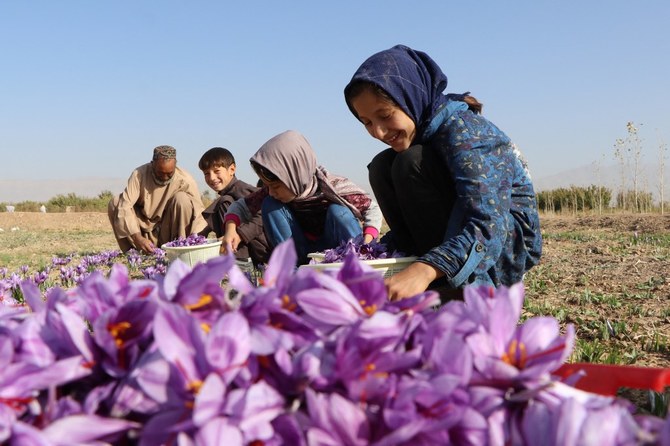KABUL: Afghans are eyeing Middle Eastern markets to export the world’s most expensive and delicate spice, saffron, ahead of what is expected to be a bumper harvest season.
Known as “red gold,” saffron is used for color and flavor in many cuisines across Asia and the Middle East, including rice dishes, seafood, meat, and various sweets.
A part of Afghanistan’s culinary tradition, saffron cultivated in the country has been recognized as the world’s best in terms of taste and fragrance for the past two decades.
Costing about $1,000 per kilo, it is also cheaper than saffron from Iran and Spain — Afghanistan’s main competitors.
“Many countries have been interested in importing the Afghan saffron, as it ranks first in the world with its best quality ... Demand for Afghan saffron is mostly from Arab and Western countries,” Abdul Salaam Akhundzada, spokesperson for Afghanistan’s Ministry of Industry and Commerce, told Arab News.
Afghanistan sold 51,096 kg of saffron in 2022, according to the ministry’s data.
While most of it went directly to India, outside the region the main destinations were Saudi Arabia and the UAE, where the market is thought to have significant opportunity to expand given its quality and price.
Both the ministry and the country’s farmers are hopeful that exports will jump after the harvest season in the autumn, as more saffron flowers are now growing across the country’s spice-cultivating regions.
“We are sure that our harvests will increase this year, especially in Herat, Nimroz and Badghis provinces,” Akhundzada said. “We have recently received reports that the cultivation of saffron was also better and increased (in scale) in Ghor and Helmand.”
Haji Himat, director of Shahana Afghan Saffron, a producer based in Kabul, told Arab News: “The usage of saffron in Gulf countries, particularly in the Kingdom of Saudi Arabia and the UAE, is enormous ... We are hoping there will be an increase in Afghan saffron exports to these countries in the near future.
“Many investors from the Gulf countries have been interested in creating markets for Afghan saffron in their respective countries.”
Despite the anticipation of significant future growth, exports of saffron to the Gulf have yet to reach their potential largely as a result of sanctions imposed on Afghanistan by Western countries after the Taliban retook control of the country in August 2021.
“Due to the current restrictions, saffron exports have been affected,” Himat said, explaining how Afghanistan’s fertile soil, water quality and dry climate are ideal for cultivating the precious spice.
“Afghanistan has the potential, and can produce more saffron than any other saffron-producing country.”














